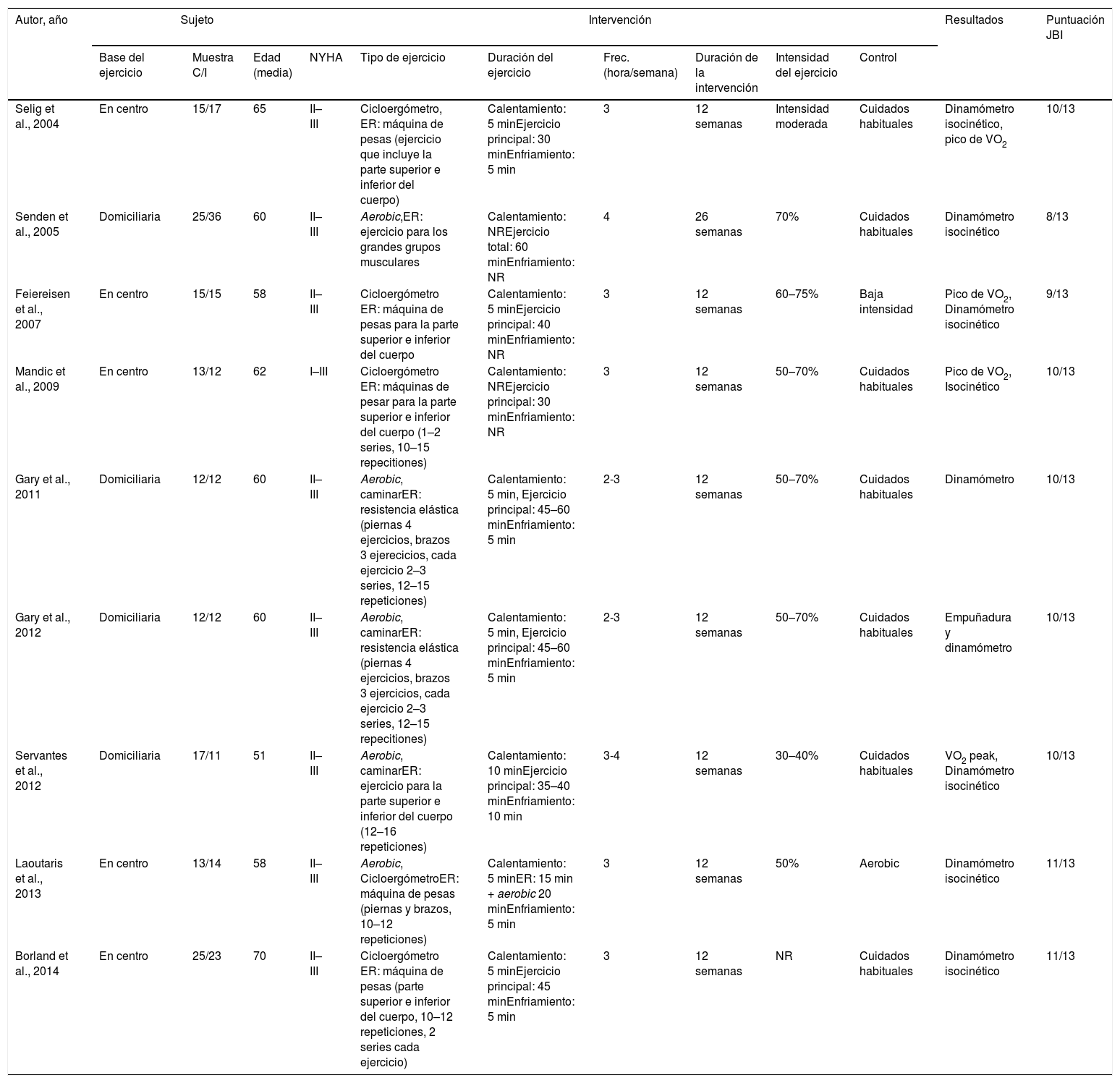Analizar los componentes de los ejercicios de entrenamiento de resistencia (ER) y evaluar los efectos de los mismos en la mejora de la fuerza muscular y el pico de consumo de oxígeno (VO2), sobre la base de la rehabilitación realizada en centros o domiciliaria en pacientes con reducción de la fracción de eyección por insuficiencia cardiaca (HFrEF).
MétodosConforme a las directrices del Reporting Items for Systematic Reviews and Meta-Analyses (PRISMA), se realizó una búsqueda de artículos a través de cinco bases de datos, incluyendo Embase, MEDLINE, CINAHL, PEDro y Cochrane. Para realizar el metaanálisis se utilizó el software RevMan 5.3.
ResultadosLos nueve estudios de ensayos controlados aleatorizados cumplieron los criterios del estudio, incluyendo un total de 299 respondedores. En los respondedores de los centros (n = 81 para el grupo de intervención vs. n = 81 para el grupo control), el ER produjo efectos significativos tanto en la fuerza muscular de las piernas (diferencia media estandarizada [DEM] = 1,46, IC del 95%,0,41-2,50, n = 151) como de los brazos (DEM = 0,46, IC del 95%,0,05-0,87, n = 97) y el pico de VO2 (DM = 1,45 mL/kg/min, IC del 95%, 0,01-2,89, n = 114). En los respondedores domiciliarios (n = 71 para el grupo de intervención vs. n = 66 para el grupo control), el ER produjo efectos significativos tanto en la fuerza muscular de las piernas (DEM = 0,58, IC del 95%, 0,20-0,97, n = 113) como de los brazos (DEM = 0,84, IC del 95%, 0,24-1,44, n = 47) y pico de VO2 (DM = 5,43 mL/kg/min, IC del 95%, 0,23-10,62, n = 89).
ConclusiónLos ejercicios de ER podrían incrementar la fuerza muscular y el pico de VO2 tanto en la rehabilitación en centros como domiciliario, y deberían considerarse parte de los cuidados de los pacientes de HFrEF.
To analyze the components of resistance training (RT) exercises and evaluate the effects of RT on improving muscle strength and oxygen consumption (VO2) peak based on either center-based rehabilitation or home-based rehabilitation in patients with heart failure with reduced ejection fraction (HFrEF).
MethodsAccording to the PRISMA guidelines, articles were searched through five databases, including Embase, MEDLINE, CINAHL, PEDro and Cochrane. RevMan 5.3 software was used to perform the meta-analysis.
ResultsNine randomized controlled trial studies met the study criteria, including a total of 299 respondents. In the center-based respondents (n = 81 for intervention group vs. n = 81 for control group), RT resulted in significant effects on both muscle strength of lower extremity (SDM = 1.46, 95% CI = 0.41–2.50, n = 151) and upper extremity (SDM = 0.46, 95% CI = 0.05–0.87, n = 97) and VO2 peak (MD = 1.45 ml/kg/min, 95% CI = 0.01–2.89, n = 114). In the home-based respondents (n = 71 for intervention group vs. n = 66 for control group), RT resulted in significant effects on muscle strength of both lower extremity (SDM = 0.58, 95% CI: 0.20–0.97, n = 113) and upper extremity (SDM = 0.84, 95% CI: 0.24–1.44, n = 47) and VO2 peak (MD = 5.43 ml/kg/min, 95% CI: 0.23–10.62, n = 89).
ConclusionThe RT exercise could increase muscle strength and VO2 peak at either center-based or home-based rehabilitation and should be considered as a part of the care of patients with HFrEF.












